|
For more than 15 years DCAT has established a presence in the journals of various building code organizations, introducing their leadership and members to the best and most current information in more sustianable construction materials and approaches. We have focused on a broad range of issues in this quest, publishing articles covering dozens of different topics. With this advocacy work has been the more technically oriented support of code adoption of alternatives like earthen and straw bale construction by local, regional and now International code organizations. It is in this area we all have something to celebrate!
As of October last year, the International Code Council approved amendments to the 2015 International Residential Code® (IRC) to include an appendix on straw bale construction. Approved 9-1 in committee, the hard work led by colleague and tireless advocate Martin Hammer bore fruit in what amounts to mainstream acknowledgement and adoption of straw bale construction by the primary building regulatory organization in the US!
It is difficult to grasp for most people the amount of effort this success represents. Along with Martin's leadership, many organizations and allied professionals assisted the development of this appendix without the aid of an industry trade group or other well-funded backers. It was done on a shoe string (like all of our work at DCAT, unfortunately), with the express intent of making a "public domain" building system more universally available for everyone.
Please read the attached PDF of the article in the February issue of the Building Safety Journal Online here.
BONUS ITEM: David provided me the image below of the online publication of ICC. He is featured prominently, and also notice the byline of this publication:
"The premier digital publication of building safety, fire prevention and sustainability." David and DCAT deserve a double pat on the back for both the acknowledgment of our contributions in the code realm, as well as the successful integration of sustainability within the primary objectives of this organization - positively influencing construction globally.
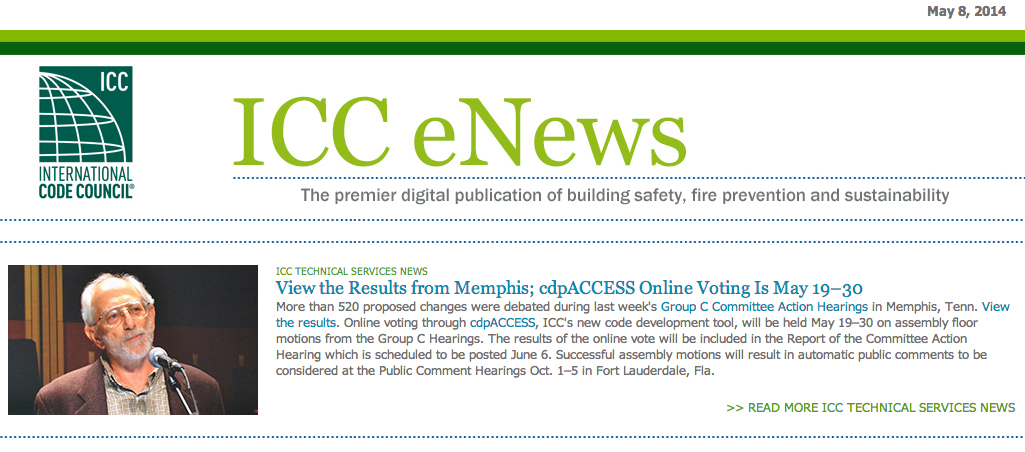
____________________
DCAT has partnered with the Green Science Policy Institute, BuildingGreen.com, Vyto Babrauskas/Fire Science & Technoloigy, and others to help lead the Safer Insulation Solution Coalition. For more information please visit the Safer Insulation Solution (SIS) website at www.saferinsulation.org. DCAT Director David Eisenberg is a co-author of the peer-reviewed paper "Flame Retardants in Building Insulation: A Case for Re-evaluating Building Codes,” published in the International journal, Building Research and Information. The publisher generously made this paper available for download without charge for the initial three months. It is now downloadable for a fee here: http://www.tandfonline.com/doi/full/10.1080/09613218.2012.744533.
The original paper submitted for publication differs slightly from the published version, but can be downloaded here or from the SIS website here (http://saferinsulation.org/wp-content/uploads/2013/07/Babrauskas-et-al-2012.pdf).
____________________
Through the graces of Matts Myhrman and S.O. MacDonald, Build it with Bales, Version Two, after some minor tweaking, is being made available as a free download. Timed to coincide with the ongoing International Straw Bale Builder's Conference, now happening in Colorado, we are grateful for the opportunity to assist in the distribution of one of the most beloved and practical manuals for straw bale construction ever assembled. Truly a standard by which all others are measured.
Enjoy!!!
Note: The book has been broken down into bite-sized chunks, for easier download... each section will open in a new browser window. From there, you can save the file (File menu/Save as...) to your hardrive for offline viewing and reference.
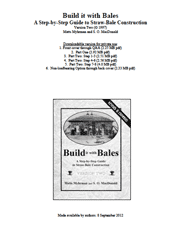 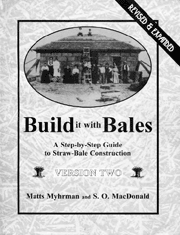 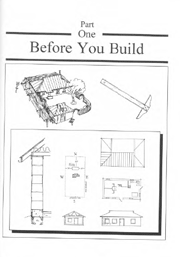
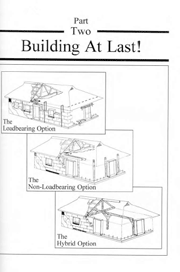 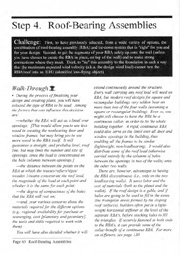 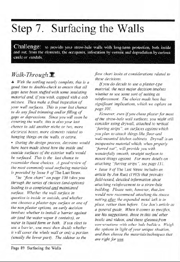
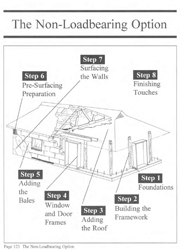 . . . or download the whole 18MB file here —> . . . or download the whole 18MB file here —> 
____________________
DCAT Director David Eisenberg was an invited delegate, presenter, and moderator at the Asia-Pacific Economic Cooperation Green Building Conference
(APEC - www.apec.org) - "Green Buildings and Green Growth: The Enabling Role of Standards and Trade" held at the Ronald Reagan Building and International Trade Center, Washington, DC, March 3rd and 4th, 2011. This conference was attended by approximately 150 people from about 20 Pacific Rim countries. A slightly modified version (there is one additional slide - #20) of David's presentation can be downloaded here.
David has also made available the PowerPoint version of his presentation, which can be downloaded via YouSendIt at the following link: APEC PowerPoint
____________________
David's Presentation to the Alternative Solutions Resource Initiative - http://www.asri.ca
Download here.
____________________
David's opening presentation for the IRCC/ICC one-day workshop in Boston on October 20, 2010 - sponsored by the International Code Council (ICC) and the Inter-jurisdictional Regulatory Collaboration Committee (IRCC). Download the presentation here, or follow this link to loads of additional resources.
____________________
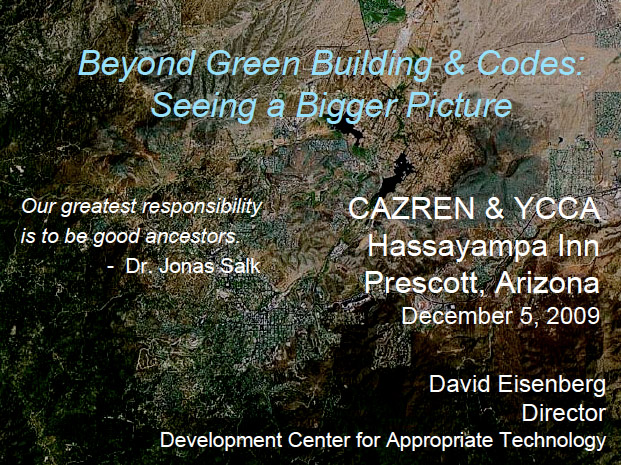
Click on the image above to download the PDF of the presentation, complete with David's speaking notes for each slide. (2.9 MB PDF)
____________________
"Code, Regulatory and Systemic Barriers Affecting Living Building Projects"
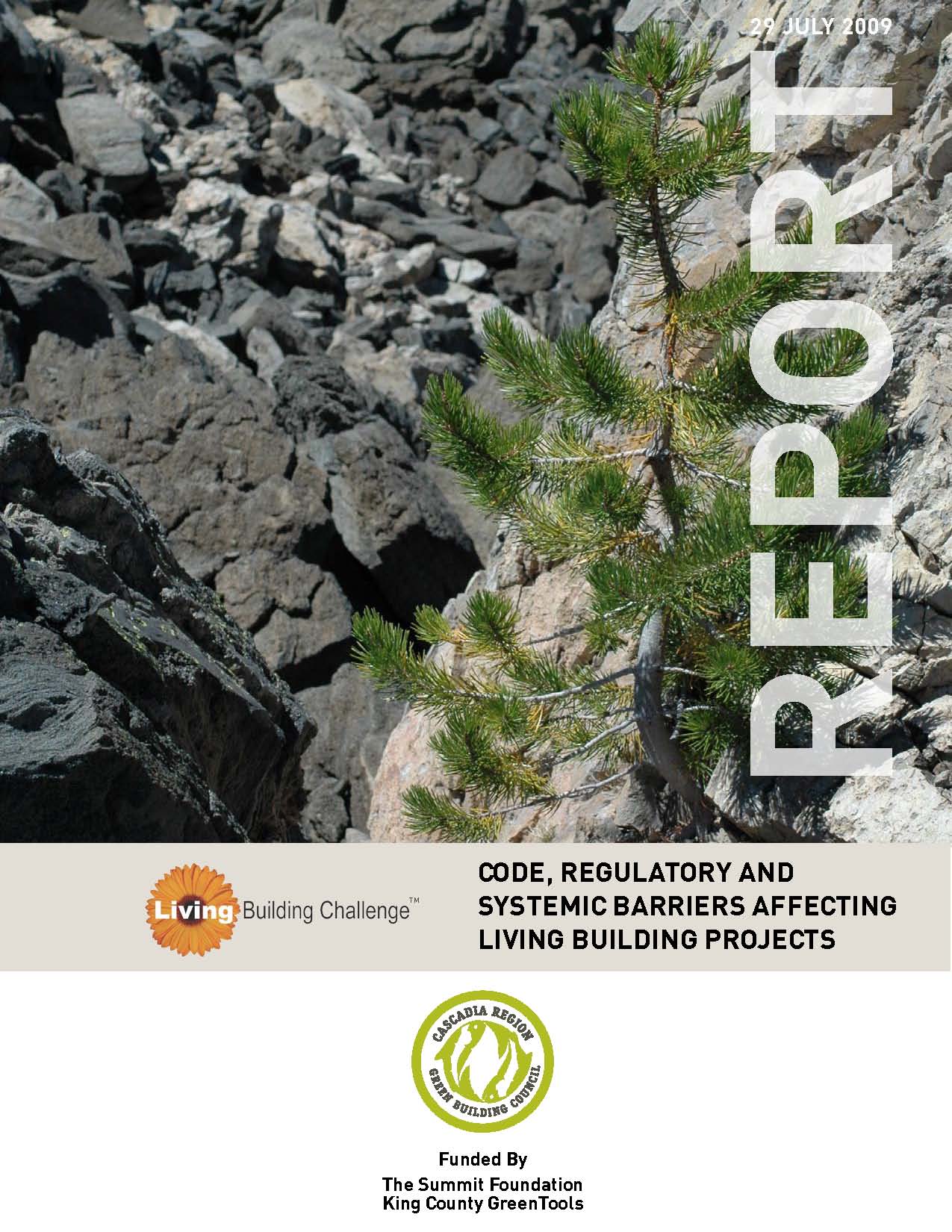
(download report here)
____________________
Breakthrough report from the Cascadia Region Green Building Council tackles building regulations
(August 4, 2009) Tucson, AZ, USA & Toronto, ON Canada – The enthusiasm for Living Buildings continues unabated, but a key stumbling block in the shift toward truly sustainable projects is the existing set of codes and regulations. Federal stimulus funds for green building and infrastructure projects are important drivers of the shift in how buildings are designed and constructed, but there needs to be a “greening” of the regulatory systems to fully meet sustainability goals.
Stepping in to help resolve the impasse is a new report published by the Cascadia Region Green Building Council entitled Code, Regulatory and Systemic Barriers Affecting Living Building Projects, which presents a case for fundamental reassessment of the regulatory sphere related to the built environment.
“This report will reframe the conversation about building regulation and what is required to safeguard public health, safety and welfare,” says Jason F. McLennan, CEO of Cascadia and the creator of the Living Building Challenge. The Challenge is a call to those in the design and construction industries to create buildings that function like plants and are net-zero in energy, water and waste.
Greg Kats, Managing Director of Good Energies, notes, “This report is both timely and important. There are widespread obstacles to adopting green design. This report maps out these obstacles in detail and provides a series of integrated recommendations to eliminate them and replace them with a regulatory environment that supports smarter, greener healthier design.”
Report authors David Eisenberg of the Development Center for Appropriate Technology and Sonja Persram of Sustainable Alternative Consulting researched the issues surrounding regulatory barriers in the US and Canada. These included examining the range of regulatory and other approvals required for leading-edge projects, as well as surveying Living Building project teams and interviewing experts throughout North America.
According to lead author David Eisenberg, “Though people speak of the building regulatory system, it isn’t a system. It was never designed as one, and so it is not based on over-arching societal goals or system principles. Instead, what we have today emerged from thousands of reactions to problems serious enough to require a regulatory response. We need a comprehensive regulatory system that enables best practices, instead of simply preventing the worst from happening.”
Recommendations also include the creation of an integrated regulatory process that would embrace Living Building goals, explicitly considering human and ecosystem health today and tomorrow. This process would formalize regulatory relationships between the traditional regulatory spheres for the built environment and those in the finance, real estate, investment and insurance sectors.
“Green building has reached a tipping point,” notes Sonja Persram. “There is a growing recognition in the insurance and investment communities that organizations have a fiduciary responsibility to address climate change. An increasing body of research links specific green building practices with mitigating these ecological risks and adding enormous triple-bottom-line benefits. This means money now spent on conventional projects rather than on these green measures could be seen as money at risk.”
Kats concurs: “The gravity of climate change requires that we move quickly to embrace deep improvements in energy efficiency and in use of renewables to achieve zero net CO2 buildings. Building green is cost effective and provides both financial returns and a reduction of risk for owners and tenants. This report provides an important roadmap toward buildings that cut costs, cut risk, improve heath and allow us to live within our earth’s increasingly imperiled environmental means.”
The project was made possible through funding to Cascadia from the Summit Foundation and King County.
Access the report from any of these weblinks:
Development Center for Appropriate Technology: www.dcat.net/about_dcat/announcements.php
Sustainable Alternatives Consulting Inc.: www.sustainable-alternatives.ca/Cascadia_Code_Report_Eisenberg_Persram.pdf
Cascadia Region Green Building Council: http://ilbi.org/resources/research/CodeStudies/09-0729%20code%20paper%20Eisenberg.pdf
About the Authors:
David Eisenberg, Co-founder and Director of the non-profit Development Center for Appropriate Technology (DCAT), has pioneered efforts to create a sustainable context for building regulation since 1995. He served two terms on the Board of Directors of the U.S. Green Building Council where he founded and chairs the USGBC Code Committee. He has written and presented extensively on sustainability and building regulation in the U.S. and abroad. He was recently selected to serve on the new International Code Council Sustainable Building Technology Committee. David and DCAT were recipients of the International Code Council 2007 Affiliate of the Year Award and the 2007 USGBC Leadership Award in the category of Organizational Excellence.
Sonja Persram, BSc, MBA, LEED® AP is President of Sustainable Alternatives Consulting Inc., a policy and market research firm that aims to catalyze green building sector expansion, focusing on triple-bottom-line alternatives. Sonja’s publication credits include: Green Buildings: A Strategic Analysis of the North American Markets for Frost & Sullivan; the USA segment of Canada Mortgage and Housing Corporation’s International Sustainable Building Policy Initiatives; and lead author of two Canada Green Building Council projects, Marketing Green Buildings for Owners/Tenants of Leased Properties. She is a Corresponding Committee member of the USGBC’s Code Committee and served on the USGBC Social Equity Task Force.
About Cascadia:
The Cascadia Region Green Building Council is a non-profit organization in both the US and Canada. Cascadia promotes the design, construction and operation of buildings in Alaska, British Columbia, Washington and Oregon that are environmentally-responsible, profitable and healthy places to live, work and learn. Cascadia is one of the first chapters of the US and Canada Green Building Councils, and is the only international chapter in North America. It is also the originator of the Living Building Challenge. For more information, please visit www.cascadiagbc.org.
Media contacts:
Authors:
David Eisenberg, Development Center for Appropriate Technology
strawnet (at) aol.com / 520.624.6628
www.dcat.net
Sonja Persram, Sustainable Alternatives Consulting Inc.
sonja (at) sustainable-alternatives.ca / 416.324.9388
www.sustainable-alternatives.ca
Publisher:
Jason McLennan, Cascadia Region GBC
jason (at) cascadiagbc.org / 206.223.2028
www.cascadiagbc.org
###
____________________
Builders Without Borders Creating SB Demo Project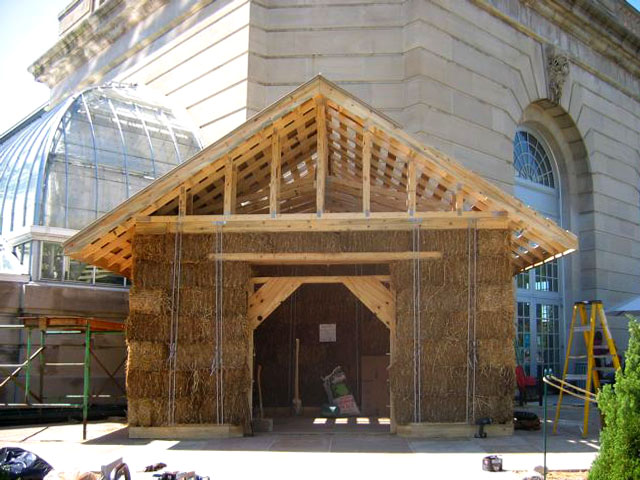
photo: Laura Bartels
Joining a summer-long exhibition at the U.S. Botanic Garden in Washington D.C., Builders Without Borders is creating a straw-bale eco-house to demonstrate energy-efficient design and green building techniques. The exhibit will be on display from Memorial Day through Columbus Day, Saturday May 24 - October 13, 2008.
Read more at: http://builderswithoutborders.org/index.htm
____________________
On June 20, 2008 the Environmental and Energy Study Institute (EESI) hosted a briefing about straw-bale construction and how it can help address some of our most serious national policy challenges, such as record energy prices and unemployment, inadequate supply of affordable housing, the threat of climate change, and pressing needs in transportation and infrastructure funding. The modern building industry places heavy demands on the energy and transportation sectors. Straw is a locally-sourced, widely available, and renewable resource that builders, architects, engineers, and home owners are turning into affordable, safe, durable, and energy-efficient buildings in many climates. The presenters (Laura Bartels, President of Greenweaver Inc.; Sandy Wiggins, Principle of Consilience, LLC and past Chair of the US Green Building Council; Bob Gough, Secretary of the Intertribal Council On Utility Policy; and DCAT Director David Eisenberg) discussed the benefits of using this American invention, the regulatory barriers and institutional biases against straw-bale construction, and the role of the federal government in resolving these issues. An audio recording of the entire briefing and the Powerpoint presentations are all downloadable here.
____________________
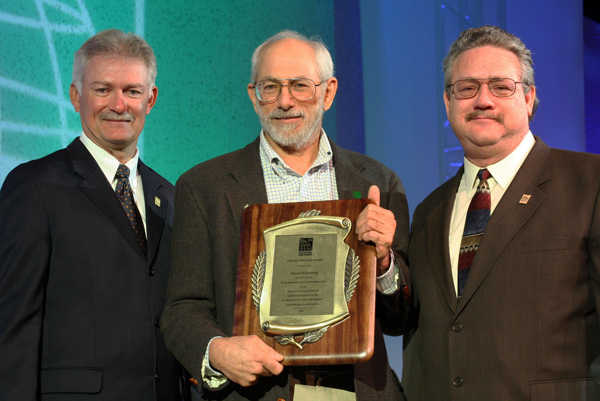
International Code Council Immediate Past President Wally Bailey (left) and Awards Committee Chairman John Darnall (right) present the ICC Affiliate Award to David Eisenberg, Executive Director of the Development Center for Appropriate Technology at the ICC Annual Conference on October 3rd in Reno, Nevada.
October 12, 2007
Acknowledging the pioneering work of David Eisenberg and the Development Center for Appropriate Technology (DCAT) in promoting sustainability in building and building codes, the International Code Council (ICC) named DCAT their 2007 Affiliate of the Year. The award was presented at the ICC Annual Conference in Reno, Nevada on October 3rd. The ICC Affiliate Award is given in recognition of an individual or organization that consistently demonstrates integrity, professionalism and dedication to building code development, public safety, and public service.
“David’s decades of work in green building education and code development for alternative building materials has helped make sustainability a common concept,” said International Code Council Immediate Past President Wally Bailey. “As a regular contributor to ICC’s magazine, Building Safety Journal, David explains how building codes can support the responsible use of resources to create safe and sustainable communities. As the Code Council continues to define its role in green building, we have David to thank for educating us on how to include sustainability into the codes and protect our world for generations to come.”
The ICC Awards video shown at the opening plenary session of the conference noted: “Currently Chair of the U.S. Green Building Council’s Code Committee, David played a key role in the agreement between the USGBC and the ICC to promote a joint effort to educate building officials about green building and include green building practices in the I-Codes.” The first results of that agreement were the half-day and full-day green building education classes that David, the USGBC Code Committee, ICC staff, and others developed and taught at the conference in Reno. In addition, we’re helping develop a guide to sustainability and green building is in development that will be jointly published by ICC and USGBC.
DCAT’s ten-year-old program, Building Sustainability into the Codes, has included a wide variety of activities and efforts to educate the building codes community about the full range of consequences, risks and responsibilities involved in safeguarding public health, safety and welfare in relation to the built environment. The collaborative approach and quality of relationships DCAT developed resulted in the opportunity to help create six feature issues and dozens of articles on topics related to sustainability and green building in the magazines of ICC and the legacy code groups. Additionally, DCAT was given a regular column called “Building Codes for a Small Planet” in Building Standards magazine and later in ICC’s Building Safety Journal. DCAT also produced an educational video with the same name for building officials. That video is currently available from DCAT on DVD.
Click here to download the DCAT Affiliate Award Release as a pdf file or here to view the ICC press release.
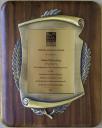
____________________
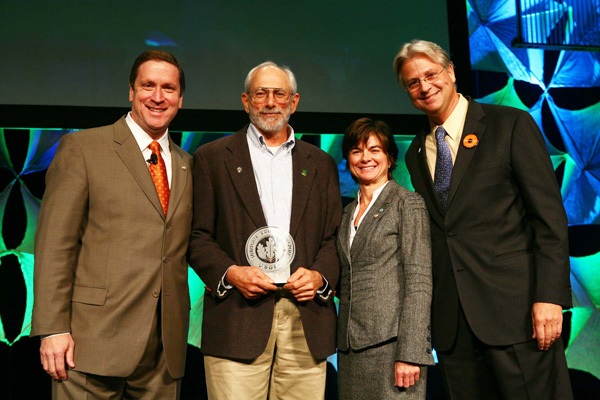
DCAT Director David Eisenberg accepts the USGBC 2007 Leadership Award in the category of Organizational Excellence at the Greenbuild Conference in Chicago, Illinois on November 8th. From left to right, USGBC CEO Rick Fedrizzi, David Eisenberg, 2008 USGBC Board Chairwoman Rebecca Flora, and 2007 USGBC Board Chairman Sandy Wiggins.
The Development Center for Appropriate Technology (DCAT) received the U.S. Green Building Council’s (USGBC) 2007 Leadership Award in the category of Organizational Excellence today at the USGBC’s annual Greenbuild International Conference and Expo in Chicago, Illinois. These awards recognize the most influential green building leaders who signify vision, leadership and commitment to the evolution of green building design and construction. USGBC Leadership Awards are given annually in six categories: Community, Education, LEED, Organizational Excellence, Research and Advocacy.
“The organizations and individuals represented at the awards truly embody the attributes expected of a green building leader,” said Rick Fedrizzi, President, CEO & Founding Chair, USGBC. “It is because of their passion and expertise that our mission of transforming the built environment within a generation has gained momentum.”
In presenting the award, Sandy Wiggins, outgoing Chairman of the USGBC Board of Directors, said, “David has profoundly influenced many of us, but also has influenced lots of other folks to adopt green building practices on a grassroots level. He singlehandedly took on one of the toughest and most important sectors of our industry – the building code officials. He has effectively communicated to mainstream industry the importance of integrating green design principles into municipal codes. He’s been tireless in his efforts to communicate and to work hands-on with green builders in the U.S. and internationally to develop better green buildings. DCAT is an organization that has been instrumental in going to the top; in moving code officials to become aware of the green building movement, and this year was also named the International Code Council’s (ICC) 2007 Affiliate of the Year.”
David served two terms on the USGBC Board of Directors and currently chairs the USGBC Code Committee, which he helped establish. DCAT played a key role in negotiating the agreement between the USGBC and the ICC to jointly educate building officials about green building and include green building practices in the I-Codes. The first results of that agreement were half-day and full-day green building classes that David, the USGBC Code Committee, ICC staff, and others developed and taught at the ICC Annual Conference in Reno, Nevada in early October. In addition, ICC and USGBC are developing a guide to sustainability and green building for code officials that will be jointly published next year.
DCAT’s ten-year-old program, Building Sustainability into the Codes, has included a wide variety of activities and efforts to educate the building codes community about the full range of consequences, risks and responsibilities involved in safeguarding public health, safety and welfare in relation to the built environment. DCAT has also been educating the green building community about its potential and responsibility to engage more fully in the code development process. Their collaborative approach and focus on the quality of their relationships has enabled DCAT to bring the green building and building codes communities together to further their common goal of creating a safer world for everyone.
Click here to download a pdf file of the DCAT USGBC Leadership Award press release. For more information visit the USGBC website or click here for the USGBC press release. The Leadership Award presentations and Paul Hawken’s inspiring keynote can be viewed online at Greenbuild365 (to see the video clip Paul mentions - but isn’t visible in the online video of his keynote - visit the Blessed Unrest website).
See what other’s have to say about this award - Mark Piepkorn’s Blog at BuildingGreen.com and Bill Walsh’s comments in the Healthy Building Network newsletter, Greenbuild 2007 from A to Z.
Read interviews with some of this year’s USGBC Leadership Award winners, including David Eisenberg, In The News on the USGBC website.
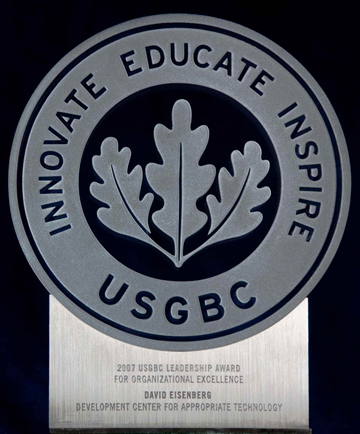
____________________
The International Code Council and U.S. Green Building Council have signed a Memorandum of Understanding to further green building practices between the two organizations. The agreement, which was signed during Building Safety Week, calls for both organizations to identify cooperative areas of interest and to work together on industry advocacy and public policy matters.
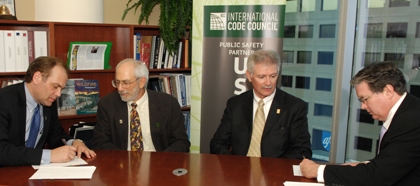
From left, Code Council CEO Rick Weiland, U.S. Green Building Council Greening the Codes Committee Chair David Eisenberg, Code Council Board President Wally Bailey and USGBC Public Policy Director Joe Maheady sign the MOU to further green building practices between the organizations.
############
For Immediate Release
Contact:
Taryn Holowka, USGBC
202.828.1144; tholowka@usgbc.org
Gretchen P. Hesbacher, ICC
1-888-ICC-SAFE (422-7233), ext. 6240; ghesbacher@iccsafe.org
U.S. Green Building Council and International Code Council Formally Commit to Joint Educational, Business, and Policy Initiatives to Further Green Building Practices
May 25, 2007 -- (Washington, D.C.) – The U.S. Green Building Council (USGBC) and the International Code Council (ICC) have signed a Memorandum of Understanding that forges a stronger relationship between the two organizations in order to further green building practices.
“This agreement with the International Code Council and USGBC opens the door to a better quality of life for us all,” said Rick Fedrizzi, President, CEO & Founding Chair, U.S. Green Building Council. “Human health and well-being is a cornerstone of green building practices and of ICC’s work. Joining together in a formal agreement ensures that we will share ideas, education, and opportunities."
ICC’s vision is to protect the health, safety, and welfare of people by creating better buildings and safer communities. This vision is congruent with USGBC’s core purpose: to create an environmentally responsible, healthy, and prosperous environment that improves the quality of life. The MOU recognizes the leadership roles of both of the organizations, while laying out areas of mutual interest, such as advocacy and education initiatives, in which USGBC and the Code Council can work cooperatively to advance their missions. The MOU also addresses exploring and implementing joint business opportunities.
“Signing this agreement with the U.S. Green Building Council reinforces the Code Council’s commitment to the environment and assures that our members play an important role in matters related to green building,” said ICC CEO Rick Weiland. “Green building is going to play an important role in our collective future—not just in the United States but around the world.”
The initial activities pursuant to the MOU will focus on education for code officials. Both organizations will develop a green building education manual on the subject of building codes and sustainability.
Added Fedrizzi, “The foundation for USGBC’s relationship with ICC was helped along by David Eisenberg, former USGBC Board member and chair of USGBC’s Greening the Codes Committee. David is with the Development Center for Appropriate Technology and has been a long time advocate of a greening building code.”
ICC plays a key role in the area of safety for the built environment to create better buildings and safer communities. USGBC is transforming the built environment to high-performance green building practices. USGBC and ICC will work together to advance buildings that are environmentally responsible, profitable and healthy places to live and work.
###
About USGBC
The U.S. Green Building Council is the nation's leading coalition of corporations, builders, universities, government agencies, and nonprofit organizations working together to transform the way buildings are designed, built and operated. Green buildings are environmentally responsible, profitable and healthy places to live and work. Since its founding in 1993, the Council has grown to more than 9,000 member companies and organizations, a 90-person professional staff, a broad portfolio of LEED® green building products and services, the industry's popular Greenbuild International Conference and Expo (www.greenbuildexpo.org) and a network of over 70 local chapters, affiliates and organizing groups.
About ICC
The International Code Council, a membership association dedicated to building safety and fire prevention, develops the codes used to construct residential and commercial buildings, including homes and schools. Most U.S. cities, counties and states that adopt codes choose the International Codes developed by the International Code Council.
############
|